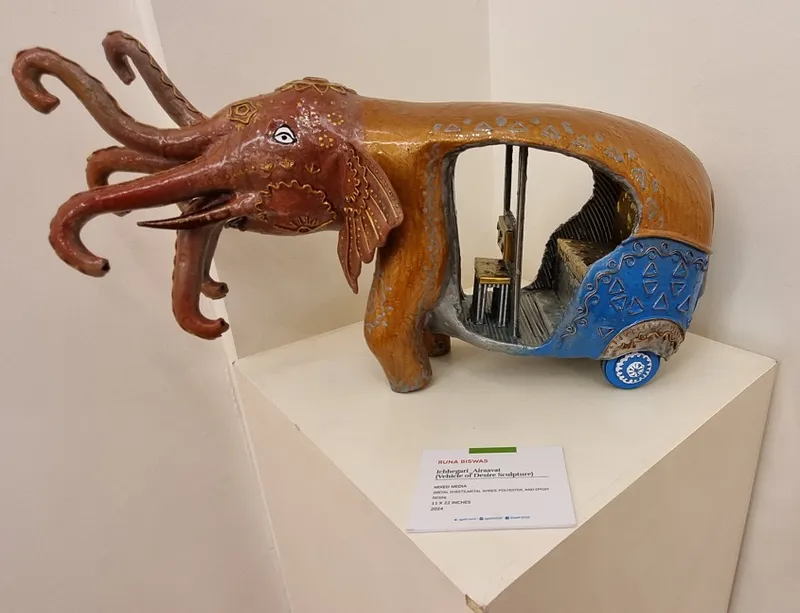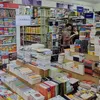Preservation, curation, investment – how Gallery G strengthens the art ecosystem
In our second photo essay from Bengaluru’s Gallery G, we present more artistic highlights and curator insights from the ongoing exhibition.
Launched in 2014, PhotoSparks is a weekly feature from YourStory, with photographs that celebrate the spirit of creativity and innovation. In the earlier 790 posts, we featured an art festival, cartoon gallery. world music festival, telecom expo, millets fair, climate change expo, wildlife conference, startup festival, Diwali rangoli, and jazz festival.
Gallery G at Lavelle Road in Bengaluru is hosting a group exhibition this month, featuring the works of eight artists from across India. Titled Mosaic of Modernity: Exploring Diversity in Art, the artworks span Indian motifs, landscapes, religion, and urban life.
The profiled artists are Jai Khanna, Dinesh Magar, Aarohi Singh, Damodar Aware, Tushar Shinde, Runa Biswas, Annamicka Kuchhan, and Tridib Bera. See Part I of our coverage here.
“We looked for pieces that not only displayed technical excellence but also conveyed relevant stories and perspectives that resonate with the complexities of modern life in India. The artists and artworks were chosen based on their ability to represent this theme with originality and depth,” Archana Shenoy, Director of Curatorial Practices, Gallery G, tells YourStory.
The displayed artworks depict spiritual themes by Dinesh Magar, abstract works by Damodar Aware, urban life and cityscapes Tushar Shinde, collage and mixed media by Runa Biswas, nature themes by Annamicka Kuchhan, and societal issues by Tridib Bera.

“Visitors have appreciated the diversity and thought-provoking nature of the artworks. The feedback highlights the emotional and intellectual impact of the exhibition,” Shenoy proudly says.
She calls for more art appreciation in India through enhanced education and accessibility. “Incorporating art education into school curriculums can foster an early appreciation and understanding of art,” she suggests.
Public art installations and community projects can make art more accessible to a broader audience. “Digital platforms and virtual exhibitions can reach people who might not visit traditional galleries,” Shenoy adds.

She also advises holding more dialogue and engagement through workshops, artist talks, and interactive sessions. They help deepen appreciation for artists' work and strengthen the broader ecosystem.
Gallery G offers artworks for sale in several categories: modern, contemporary, and traditional art, as well as photography. The team sources from and represents collectors of antiquities and rare heritage pieces such as Mysore Tanjore paintings and Tibetan thangkas.
Artworks are also evaluated based on inputs from peer galleries, curators, consultants, auction houses, and collectors. Other services include restoration, preservation, and art investment advisory.

Painting frames are sourced from Bengaluru and Kolkata, or even imported. Exhibitions are curated at the gallery and in public spaces such as corporate lobbies, hotel gardens, airport terminals, and mall atria.
“Success as a curator is defined by the ability to create exhibitions that resonate deeply with audiences and provoke thoughtful dialogue. It's about curating shows that not only display artistic excellence but also engage with social and cultural issues in meaningful ways,” Shenoy explains.
This involves supporting artists in their careers and contributing to the cultural landscape as well. “Ultimately, it's about making a lasting impact through the exhibitions curated,” she says.

In that regard, the ongoing exhibition is a testament to the talent and diversity of contemporary Indian art. “I encourage everyone to continue engaging with art, supporting local artists, and fostering a culture of appreciation and dialogue,” she urges.
“Together, we can create a vibrant and dynamic art community that enriches our society,” Shenoy signs off.
Now what have you done today to pause in your busy schedule and harness your creative side for a better world?















(All photographs were taken by Madanmohan Rao on location at the gallery.)
Edited by Affirunisa Kankudti









